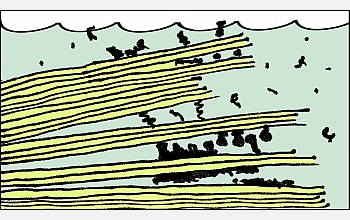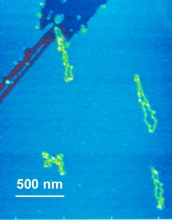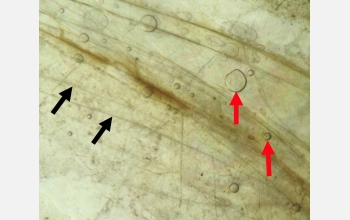Life on Earth may have originated as the organic filling in a multilayer sandwich of mica sheets, according to Helen Hansma of the National Science Foundation and the University of California, Santa Barbara.
In a presentation at the American Society for Cell Biology’s 47th annual meeting, she proposes that the narrow, confined spaces between nonliving mica layers could have provided exactly the right conditions for the rise of the first biomolecules.
The “mica hypothesis” provides possible answers to many questions about life’s origins, according to Hansma. This layered mineral could have provided support, shelter, and an energy source for the development of precellular life, while leaving artifacts in the structure of living things today, including the periodicity of RNA. Mica’s many adjacent compartments⎯the spaces between the sheets⎯would also offer the isolation needed for Darwinian evolution.

The mica hypothesis advances older models that life originated in a prebiotic “soup” in ancient oceans. The “soup” hypothesis couldn’t explain how the earliest biomolecules came together and organized into the complex structures of life.
Neither could another model (the so-called “pizza” hypothesis) that biomolecules originated on the surfaces of minerals from the earth’s crust; this hypothesis can’t explain how the earliest biomolecules obtained the right amount of water to form stable biopolymers.
On the other hand, the first living molecules would have been right at home on mica.

Mica consists of water-loving 2-nanometer (nm)-thick mineral sheets, with a hexagonal array of anionic sites spaced 0.5 nm apart, and potassium ions bridging to sites on adjacent sheets. Like cells, the spaces between mica sheets are potassium rich.
Submerged mica layers would also have had an external environment of sodium-rich sea water. Like the cell cytoplasm, the spaces between mica sheets are negatively charged and interact with a variety of inorganic cations. Single-stranded nucleic acids such as RNA have an anionic phosphate spacing of 0.5 nm, like the periodicity of mica.
Finally, the mechanical energy generated by the movement of mica sheets in response to ocean currents and temperature changes could have driven the earliest biochemistry, rearranging molecules and forming bonds between them.

Paper titled, "Mica and the Origin of Life: Cells without Membranes", presented at 12 noon to 1:30 p.m., Tuesday, Dec. 4.





Comments